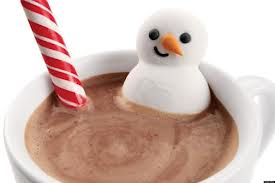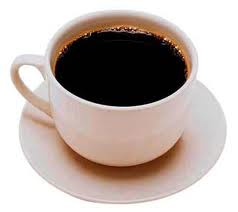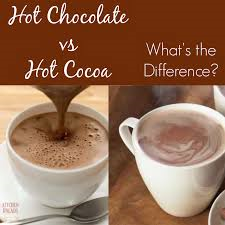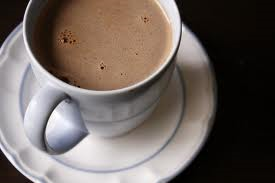Grab your favorite Santa Claus mug, Brooke P. has some hot cocoa knowledge and recipes to share with us!
I must admit I am an avid coffee drinker, but during this time of year I always enjoy my hot chocolate. However, I wanted something that I could make from home, so I would have to keep buying the pre-packaged/process stuff (and maybe save a little money in the process!). Lucky for us, Brooke P. is here to provide us some insight when choosing our hot beverage of the season as well as with a homemade alternative. Whatever you “cup of tea” might be, there is something for you to enjoy! Thanks again Brooke and sip away you guys!
Putting the Healthy in Hot Beverages
As I made my way to Butler on this snowy, cold, blustery day, I couldn’t help but stop at the Starbucks drive-thru to splurge on my favorite drink (a Grande Soy Latte, in case you were wondering). A little caffeine to wake me up, a healthy dose of calcium and vitamin D and the warmth of a hot drink to take the chill off–what’s not to love! This is the time of year when there is not much to take the edge off the stress of final papers and exams; it’s when a cozy place to study and a hot drink is about all there is. It might make you start to wonder, though, just how healthy is my favorite hot beverage?
When I think of hot drinks, the ones that come to mind are coffee, tea and hot chocolate or cocoa, and these can all vary widely in their “healthfulness.” The good news is that there are many ways to enjoy these drinks and still keep calories, fat and caffeine in check! Nutritionally, coffee, tea and hot cocoa are all good sources of antioxidants — compounds that protect cells from damage that can lead to chronic diseases like cancer, heart disease and diabetes. Among other things, coffee consumption has been linked to a reduced risk of Type II diabetes and Alzheimer’s disease, and tea (black, green and oolong) to a decreased risk for cancer and heart disease. Like tea, cocoa powder is a rich source of antioxidants called flavonoids, making cocoa-containing beverages an occasional healthy choice, too! (To find out more about the health benefits of chocolate and how hot cocoa differs from hot chocolate, see Nutrition Condition February 2013).
All of these drinks also contain some caffeine, but coffee tops the list. An 8-ounce cup of coffee can range from 95-200mg of caffeine, whereas an 8-ounce cup of tea has only 14-61mg. A one ounce shot of espresso falls in between at 45-70mg; this makes a Grande (16-ounce) Starbucks Latte (brewed from espresso) weigh in with nearly half the caffeine of a Grande Pike Place brew (330mg)! As for chocolate, one cup of semi-sweet chocolate chips has about 104mg of caffeine (about 17mg per ounce). By comparison, one ounce of Lindt dark chocolate has 20mg of caffeine, whereas one ounce of milk chocolate has 6mg and white chocolate, only 2mg. In other words, the stronger the coffee and the darker the chocolate (higher percentage of cocoa), the more caffeine it contains. (Note: do not confuse strong coffee with a “bold” or dark roast coffee. Dark roasted coffee beans actually contain less caffeine than their light roasted counterparts.)
From a health standpoint, the countless studies on coffee have, yet, to show that moderate caffeinated coffee consumption, defined as the equivalent of about 2-4 cups of brewed coffee per day or 200-300mg/day, is harmful. Keep in mind that individuals vary in their sensitivity to caffeine, but for most people, a cup or two of “Joe” may make it easier to stay alert and focused to take that final exam or finish that research paper! When is consuming caffeine potentially harmful to your health? Excess caffeine can increase blood pressure and anxiety, so if you find yourself feeling jittery, more nervous or having trouble sleeping, it’s sign to reduce your intake. This is when a healthful alternative “pick-me-up” for a day of studying would be a brisk walk, a few jumping jacks or a 20 minute nap.
As for tea, both caffeinated and decaf tea contain similar levels of antioxidants, and herbal teas have health benefits, too. Along with antioxidants, herbal teas like chamomile and peppermint may help reduce stress and induce sleep due to their calming effects. If possible, don’t add milk to your tea or coffee, though, as this can lessen the antioxidant advantage!
Hot chocolate and hot cocoa are often used interchangeably. From a purest standpoint, hot cocoa is made from ground chocolate mixed with hot milk, whereas hot chocolate comes from ground cocoa powder that is mixed with sugar and milk. Nutritionally, the important thing is the cocoa content in the beverages. Hot chocolate made from a darker variety of chocolate (>65% cocoa) will have more cocoa content than milk chocolate. Finely ground cocoa powder mixed with sugar and milk will provide more flavonoids than a packet of most commercial hot chocolate mixes. Most importantly, be wary of unhealthy trans-fats that are frequently found in these hot chocolate mixes; they are present if partially-hydrogenated oil is on the ingredient list. (For more information on hot chocolate versus hot cocoa, see Nutrition Condition, February 2013).
You can also make hot cocoa mix at home with this recipe, adapted from Alton Brown at Food Network. An 8-ounce mug would be a reasonable indulgence!
Hot Cocoa
Ingredients
- 2 cups powdered sugar
- 1 cup cocoa (Dutch-process preferred)
- 2 1/2 cups powdered milk (usually found in the Latin or baking section of the supermarket)
- 3/4 teaspoon finely ground salt, like popcorn or pickling salt
- 2 teaspoons cornstarch
- 1 pinch cayenne pepper, or more to taste (optional) — try substituting cinnamon or a teaspoon of instant coffee!
- Hot water
Directions
Combine all ingredients in a resealable container and stir with a whisk to incorporate evenly, or put the lid on and shake vigorously. In a small pot, heat 1 cup (8 ounces) or more of water.
Fill your mug half full with the mixture and pour in just enough hot water to cover it. Stir with a whisk or fork to combine until thick and smooth. Add the rest of the water to reach the top of the mug and stir again. Leftover mix in an airtight container keeps indefinitely in the pantry. This recipe also works well with warm milk or in coffee.
Note: If using regular, granulated, non-fat dry milk, reduce lumps by placing all ingredients in a food processor and pulse until a fine powder forms.
However you choose to indulge, what makes drinks like coffee, tea and hot chocolate less healthy is what you put in them! If you want to maximize the health benefits of your coffee or tea, drink them without any added milk, cream or excess sugar. However, if you choose to add milk to your beverage, just be sure it is skim, low-fat (1%) or soy, and hold the whipped cream (or save it for a special occasion). A teaspoon of sugar (a little more than one sugar cube or packet) has only about 16 calories. However, adding flavor can add 70 calories to your tall latte at Starbucks! The great news is that almost every coffee vendor offers sugar-free syrups and sugar alternatives, as well as non- and low-fat milk. What’s more, a tall, skim latte at Starbucks counts as a serving of low-fat dairy!
As you approach these last weeks in the semester and want to reach for a hot drink, a quick peak on-line at Starbucks, Dunkin’ Donuts or McDonald’s will tell you just how many calories are in your favorite beverage, then decide if you need to ask for low-fat milk, a “light” or “no-whip” version. It might just save you enough calories to splurge on that cookie to dunk in it!
References
- http://www.webmd.com/food-recipes/features/coffee-new-health-food?page=2, accessed 12/4/2013.
- http://www.ncbi.nlm.nih.gov/pubmed/20182037, accessed 12/4/2013.
- http://www.mayoclinic.com/health/caffeine/AN01211, accessed 11/27/2013.
- http://www.lindtchocolatersvp.com/rsvp-products/products-faqs/, accessed 11/27/2013.
- http://www.webmd.com/balance/features/tearooms-offer-healthy-buzz, accessed 11/27/2013.
- http://starbucks.com/menu/drinks, accessed 11/27/2013





